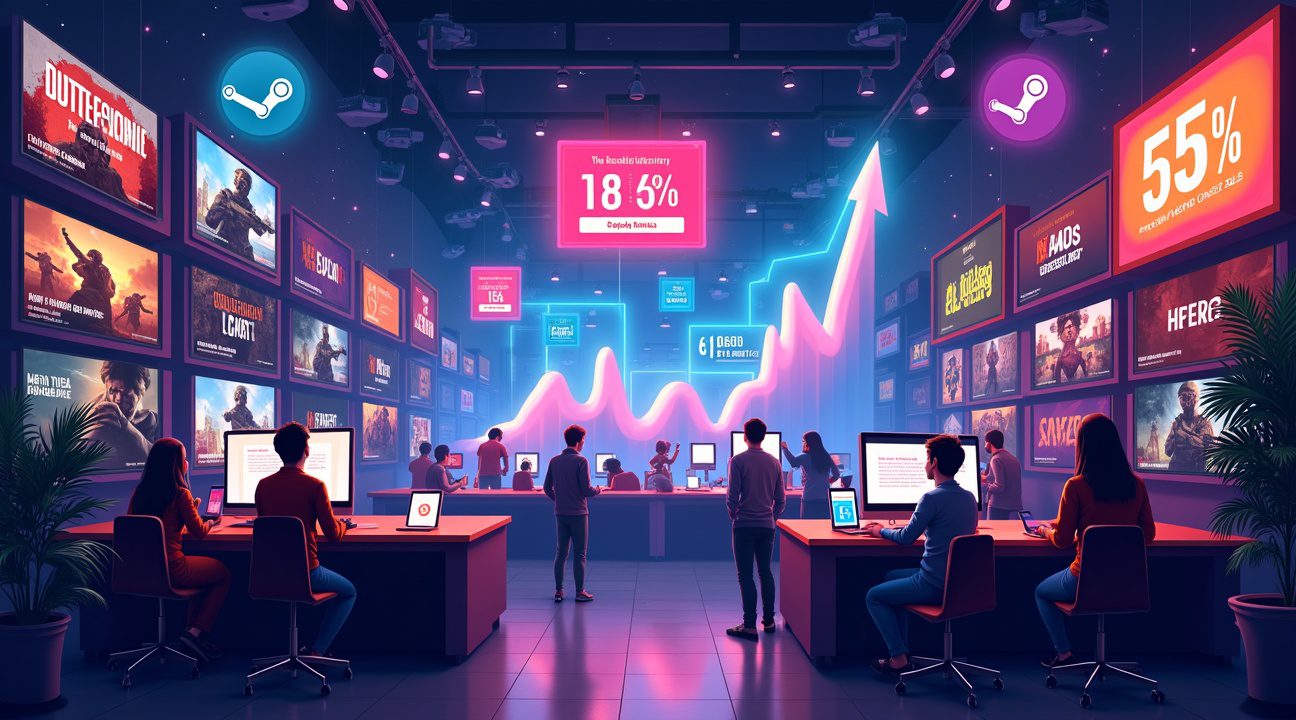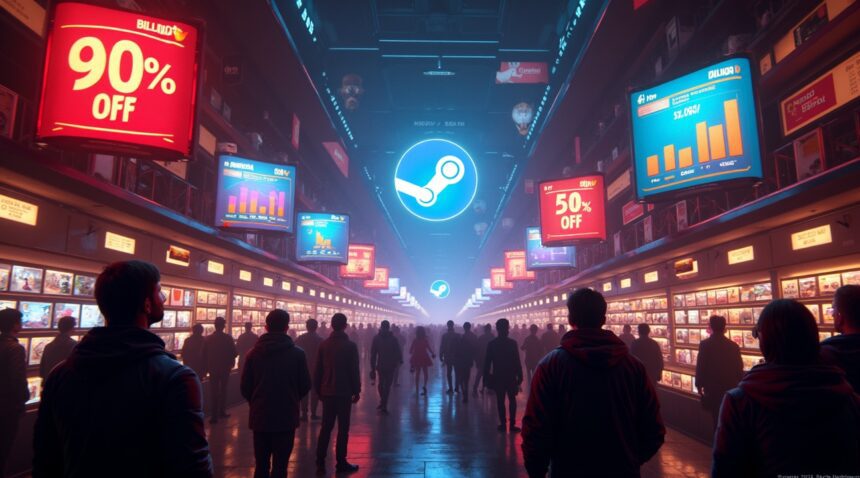Steam’s revolutionary sales model transformed digital game marketing when Valve Corporation recognized that deep discounts and strategic timing could generate massive revenue while fundamentally changing player behavior.
The platform’s visionary leaders, including co-founder Gabe Newell and key team members like Erik Johnson and Jason Holtman, developed innovative promotional strategies that turned seasonal sales events into cultural phenomena generating billions in revenue across all gaming genres.
Key Takeaways
- Steam’s seasonal sales generate extraordinary revenue spikes, with Online Co-Op games leading at $7.5 billion and Great Soundtrack games reaching $8.8 billion in total revenue.
- The platform’s strategic use of flash sales, wishlist psychology, and algorithm-driven discovery creates urgency and targeted promotions that convert browsing into purchases.
- Major sale events like Summer and Winter Sales have become industry standards that competitors now mirror, fundamentally reshaping digital retail expectations across gaming.
- Independent developers particularly benefit from Steam’s democratic promotion system, gaining visibility and competing alongside AAA titles during platform-wide discount events.
- Steam’s sales model extends game lifecycles and preserves long-term revenue streams, with classic games generating $1.4 billion through consistent participation in promotional cycles.
To learn more about the impact of Steam sales and how they’ve become integral to digital distribution strategies, check out this Steam overview page.
How Steam Sales Generate Billions in Revenue and Transform Gaming Success
Steam’s seasonal sale events create extraordinary revenue spikes that reshape the entire gaming landscape. Major events like the Summer Sale and Winter Sale don’t just offer discounts – they transform how players discover games and how developers achieve financial success on the platform.
Revenue Performance Across Gaming Genres
The financial impact of Steam’s promotional strategies becomes clear when examining genre-specific performance data. Online Co-Op games lead the charge with approximately $7.5 billion in total revenue, benefiting significantly from user acquisition during major discount periods. These multiplayer experiences thrive during sales because friends can coordinate purchases and dive into shared gaming experiences together.
Great Soundtrack games generate around $8.8 billion in revenue, demonstrating how audio excellence drives purchasing decisions. Dark Fantasy titles reach $2.7 billion, while Turn-Based games hit $1.2 billion, and Life Sim experiences earn $480 million in total revenue. Each genre benefits differently from Steam’s marketing strategies, with some seeing massive spikes during flash sales and others maintaining steady growth through featured placements.
The Scale of Financial Success
Individual game performance reveals the true power of Steam’s promotional machine. Online Co-Op games yield an average of about $1.8 million per game, highlighting the significant financial scale that successful segments can achieve. This average demonstrates how effective Steam sales are at driving substantial revenue for developers who understand the platform’s promotional dynamics.
Even specialized categories show impressive results from targeted promotions:
- NSFW tags generate approximately $190 million in total revenue
- Colony Sim games earn around $470 million
These figures prove that Steam’s sale structure benefits both mainstream and specialized content creators.
The platform’s ability to elevate player engagement during discount periods creates a multiplier effect. Developers strategically time their releases and updates around major sale events, knowing that visibility during these periods can transform a modest game into a commercial success. Steam’s algorithm rewards games that perform well during sales with increased organic visibility, creating a positive feedback loop that extends far beyond the promotional period itself.
This revenue generation model has fundamentally changed how developers approach game development and marketing. Rather than relying solely on traditional advertising, smart developers now build their entire launch strategies around Steam’s promotional calendar, understanding that a well-timed sale can generate more revenue than months of conventional marketing efforts.
The Valve Visionaries Who Revolutionized Digital Game Marketing
Valve Corporation didn’t just create a digital storefront when they launched Steam in 2003—they fundamentally transformed how games reach players through innovative sales and marketing strategies. The company’s leadership team, spearheaded by co-founder Gabe Newell, recognized early that digital distribution required entirely new approaches to pricing and promotion.
Pioneering Flash Sales and Psychological Pricing
I’ve witnessed how Valve’s introduction of flash sales created unprecedented excitement around digital game purchases. These limited-time offers, often lasting just 8-12 hours, generated urgency that traditional retail couldn’t match. The company’s seasonal sales events became cultural phenomena, with players eagerly anticipating the Summer and Winter sales that could offer discounts up to 90% off regular prices.
Erik Johnson, Valve’s project management lead, helped develop the framework for these dynamic pricing models. The company discovered that deep discounts could actually increase overall revenue by reaching price-sensitive customers who would never purchase at full price. This counterintuitive approach proved that volume could compensate for reduced margins in digital distribution.
Algorithm-Driven Discovery and Developer Empowerment
Jason Holtman, formerly Valve’s Director of Business Development, championed the platform’s recommendation engine that promotes discounted games to targeted audiences. The system analyzes player behavior, purchase history, and wishlist data to surface relevant deals at optimal moments. This algorithmic approach ensures that promotional efforts reach genuinely interested customers rather than broadcasting to everyone.
Valve’s bundle deals represent another stroke of genius—combining complementary games or entire developer catalogs at compelling price points. These packages often introduce players to franchises they might never have discovered otherwise. The company empowers developers to design their own discount strategies, creating a collaborative environment where publishers can experiment with pricing to find what resonates with their audience.
The platform’s success stems from treating sales not as desperate clearance events but as opportunities to build long-term customer relationships. Valve’s visionaries understood that satisfied customers who discover great games at fair prices become advocates for both the platform and the developers whose work they’ve enjoyed. This philosophy transformed Steam from a simple digital storefront into a discovery engine that benefits everyone in the gaming ecosystem.

Record-Breaking Games That Dominate Steam Sales Rankings
Major titles consistently leverage Steam’s seasonal sales to achieve remarkable financial milestones and user engagement spikes. Games like Counter-Strike 2 and Dota 2 use these promotional windows to attract massive player influxes, transforming discount periods into revenue goldmines. Dying Light: The Beast exemplifies how strategic timing during sales events can propel titles to the top of Steam’s charts.
Strategic Launch Timing and Revenue Impact
Gamalytic data reveals that new releases capture millions of dollars when their launches align with Steam sales periods. Publishers who coordinate their debut timing with these promotional events see exponential returns compared to standard release windows. SteamDB’s weekly updates consistently show dramatic jumps in top seller rankings following sale events, demonstrating the undeniable power of strategic price drops.
Long-term success stories like Hollow Knight and Risk of Rain 2 built their enduring popularity partly through smart participation in Steam sales. These titles capitalized on front-page exposure during discount events, converting temporary visibility into sustained player bases. I’ve observed how sales and marketing strategies can transform modest indie releases into household names through careful positioning during major promotional periods.
Older games experience remarkable renaissance moments through these sales, often achieving revenue spikes that rival their original launch performance. Indie titles particularly benefit from renewed visibility during these events, extending their revenue lifespans far beyond typical market cycles. Publishers recognize that Steam sales don’t just offer temporary boosts—they create lasting momentum that can sustain games for years.
The data consistently shows that titles participating in Steam sales maintain higher baseline sales even after promotional periods end. This phenomenon occurs because increased visibility during sales exposes games to broader audiences who might never have discovered them otherwise. Strategic price drops during these events serve as powerful user acquisition tools, building communities that continue purchasing additional content long after discounts expire.
Smart developers now plan their content release schedules around Steam’s major sale calendar, ensuring maximum impact for both new launches and existing title updates. This approach has become essential for competitive success in Steam’s crowded marketplace, where visibility often determines a game’s commercial fate.

Major Steam Sale Events and The Psychology of the Wishlist
Steam’s seasonal sales have transformed how players discover and purchase games, creating anticipated events that drive massive platform engagement. The Summer Sale, Autumn Sale, Winter Sale, and Lunar New Year Sale represent calculated marketing moments that generate historic spikes in user activity and spending patterns. These events don’t happen by accident – they leverage psychological triggers and behavioral economics to maximize both immediate sales and long-term platform loyalty.
The Strategic Timing of Seasonal Sales
Each major sale event targets specific consumer behaviors and seasonal spending patterns.
- Summer Sales: Capitalize on vacation periods when players have more gaming time.
- Winter Sales: Align with holiday gift-giving traditions and end-of-year bonuses.
- Lunar New Year Sales: Tap into international buying patterns, especially in Asian markets.
These carefully orchestrated events create urgency through limited-time offers while simultaneously reactivating interest in older titles.
Classic games have particularly benefited from this strategy, generating a combined revenue of $1.4 billion through consistent participation in these sales cycles. This figure demonstrates how strategic discounting preserves and extends the commercial lifespan of games that might otherwise fade from relevance. I’ve observed how sales strategies on Steam create sustained revenue streams for developers years after initial launch.
Wishlist Psychology and Conversion Mechanics
The Wishlist feature operates as Steam’s most sophisticated conversion tool, transforming browsing behavior into purchasing decisions.
- Users add games to their wishlists, signaling strong purchase intent.
- Steam issues sale notifications when wishlist items are discounted.
- This generates urgency through loss aversion – the fear of missing a deal.
This notification system generates significantly higher conversion rates compared to general store browsing. Players who receive wishlist sale alerts already demonstrated interest in specific titles, making them prime candidates for purchase completion. The psychological impact intensifies during major sale events when multiple wishlist items receive simultaneous discounts, encouraging bulk purchasing behaviors.
Real-time top seller rankings shift dramatically during these events, showcasing immediate visibility gains for participating games. Titles that might struggle for attention during regular periods suddenly surge to prominence through strategic pricing. This visibility boost creates a compounding effect – more visibility leads to more wishlists, which generates more future sales opportunities during subsequent events.
The genius lies in how these sales extend beyond immediate revenue generation. By reactivating demand for older titles, Steam preserves long-term interest and maintains active player bases for games that launched months or years earlier. Developers benefit from sustained engagement rather than the traditional sharp decline following launch periods.
Player engagement metrics consistently spike during major sale events, with concurrent user numbers reaching annual peaks. This increased activity creates network effects – more players online means better matchmaking, more active communities, and enhanced multiplayer experiences. The sales events thus improve the overall platform ecosystem while driving direct revenue growth.
Steam’s approach differs fundamentally from traditional retail sales because it treats discounts as relationship-building opportunities rather than inventory clearance. Each sale event reinforces the platform’s value proposition while training users to anticipate and participate in future events. This creates loyal customer bases that return predictably, making seasonal sales reliable revenue drivers for both Steam and participating developers.
How Steam Sales Became the Industry Standard and Changed Gaming Culture
Steam’s revolutionary discount-driven sales model has transformed the entire gaming industry, establishing a new standard that competitors quickly adopted. Major platforms like Epic Games Store and PlayStation Store now mirror Steam’s approach, implementing their own limited-time digital promotions to remain competitive. This widespread adoption confirms that Steam’s strategy fundamentally reshaped how digital retail operates across the gaming sector.
The platform’s influence extends far beyond simple price reductions. Consumer behavior has shifted dramatically, with many players now strategically delaying purchases until sales occur. This psychological change demonstrates how Steam’s events trained an entire generation of gamers to expect significant discounts, creating a culture where patience is rewarded with substantial savings.
The Indie Developer Revolution
Independent developers have particularly benefited from Steam’s sales ecosystem, finding these events essential for both exposure and financial survival. Small studios that might otherwise struggle for visibility can leverage platform-wide events to compete directly with AAA releases. Steam’s discovery tools and front-page visibility during sales provide indie titles with unprecedented opportunities to reach new audiences.
This democratic approach to game promotion has several key advantages for smaller developers:
- Enhanced visibility through featured placement during major sales
- Access to Steam’s recommendation algorithms that boost discoverability
- Participation in seasonal events that drive traffic across the entire platform
- Community features that help build word-of-mouth marketing
The marketing strategies on Steam have proven particularly effective for indie studios because they level the playing field. A small indie game can appear alongside major releases on the same promotional pages, something that traditional retail never allowed.
Steam’s platform creates an ecosystem where indie game success depends heavily on understanding and participating in these discount events. Developers who master the timing and positioning of their sales often see dramatic spikes in both revenue and player acquisition. This has led to a strategic approach where indie studios plan their development cycles around major Steam sales, ensuring their titles are ready for maximum exposure during peak shopping periods.
These events contribute significantly to the expansion of the broader digital marketplace by introducing players to genres and developers they might never have discovered otherwise. The psychological appeal of discounted prices encourages experimentation with unfamiliar titles, fostering a more diverse gaming culture. Steam’s sales have essentially created a testing ground where players feel comfortable taking risks on unknown games, ultimately benefiting the entire industry through increased market diversity and developer opportunity.
Sources:
Games-Stats.com – “Top Steam Tags by Sales and Revenue as of 2025”
SteamDB – “Top sellers for the week of 16 Sep — 23 September 2025”
Gamalytic
SteamDB


